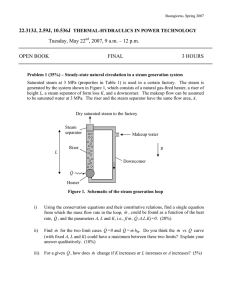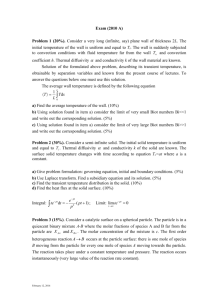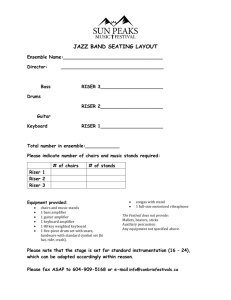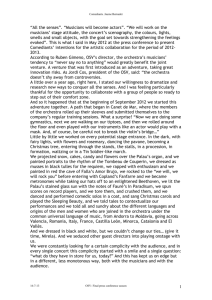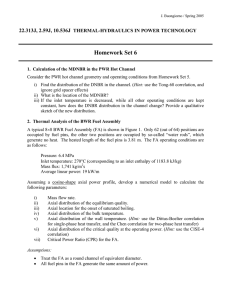22.313J, 2.59J, 10.536J Tuesday, May 22 OPEN BOOK
advertisement
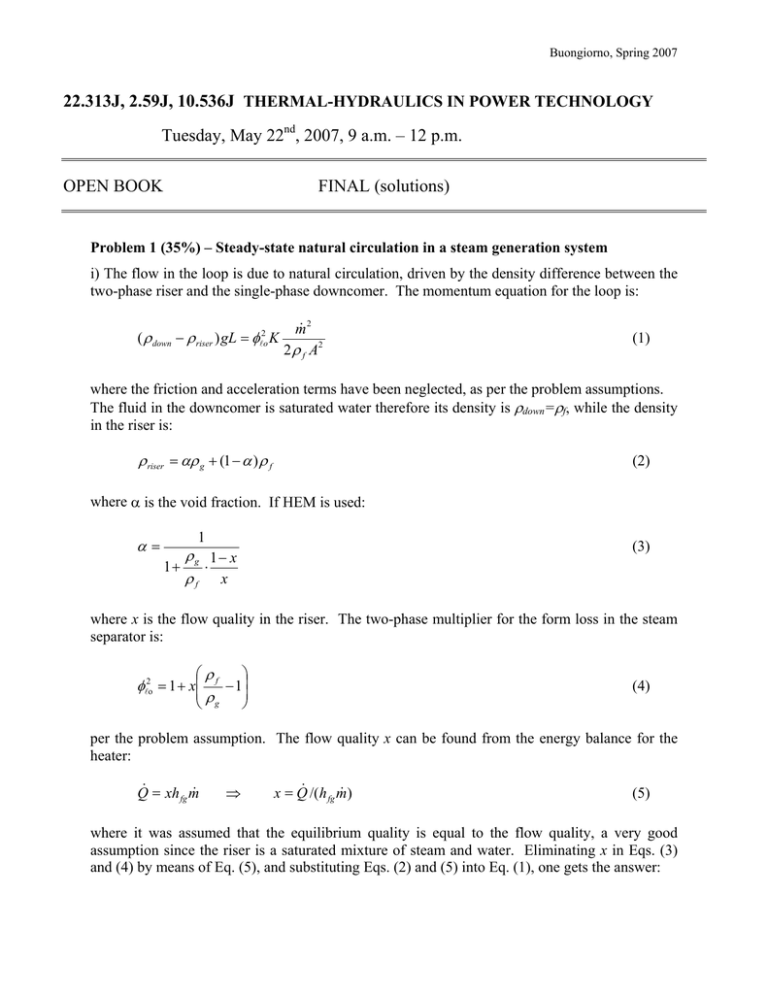
Buongiorno, Spring 2007 22.313J, 2.59J, 10.536J THERMAL-HYDRAULICS IN POWER TECHNOLOGY Tuesday, May 22nd, 2007, 9 a.m. – 12 p.m. OPEN BOOK FINAL (solutions) Problem 1 (35%) – Steady-state natural circulation in a steam generation system i) The flow in the loop is due to natural circulation, driven by the density difference between the two-phase riser and the single-phase downcomer. The momentum equation for the loop is: ( ρ down − ρ riser )gL = φl2o K m& 2 2 ρ f A2 (1) where the friction and acceleration terms have been neglected, as per the problem assumptions. The fluid in the downcomer is saturated water therefore its density is ρdown=ρf, while the density in the riser is: ρ riser = αρ g + (1− α ) ρ f (2) where α is the void fraction. If HEM is used: α= 1 (3) ρ 1− x 1+ g ⋅ ρf x where x is the flow quality in the riser. The two-phase multiplier for the form loss in the steam separator is: ⎛ ρf ⎞ −1⎟ ⎟ ⎝ ρg ⎠ φlo2 = 1+ x⎜⎜ (4) per the problem assumption. The flow quality x can be found from the energy balance for the heater: Q& = xh fg m& ⇒ x = Q& /(h fg m& ) (5) where it was assumed that the equilibrium quality is equal to the flow quality, a very good assumption since the riser is a saturated mixture of steam and water. Eliminating x in Eqs. (3) and (4) by means of Eq. (5), and substituting Eqs. (2) and (5) into Eq. (1), one gets the answer: Buongiorno, Spring 2007 ⎡ ⎞⎤ ⎛ ρf (ρ f − ρg ) m& 2 & ⎟ ⎜ & gL = ⎢1+ Q /(mh fg ) −1 ⎥ K ⎟ 2 ρ A2 ⎜ρ 1− Q& /(m& h fg ) ρ g g f ⎢ ⎠⎦⎥ ⎝ ⎣ 1+ & Q /(m& h fg ) ρ f (6) which could be solved to find m& = m& ( Q& ,A,L,K). ii) If Q& =0 (no steam), one has x=0, α=0, ρriser=ρf, and therefore m& =0. ρ For Q& = m& hfg (complete vaporization), one has x=1, α=1, ρriser=ρg, φl2o = f and From Eq. (1): ρg m& = 2 ρ g A2 ( ρ f − ρ g )gL (7) K An increase in heat rate, Q& , increases the density difference between the riser and the downcomer, which would tend to increase the flow. However, an increase in Q& also increases the quality and thus the two-phase form loss multiplier, which of course would tend to reduce the flow. Because there are two conflicting effects, a maximum in the m& vs Q& curve is possible. bThis curve is shown for some representative values of A, K and L in Figure 1, and it does in fact have a maximum. Q& /(m& h fg ) Figure 1. m& vs Q& curve Buongiorno, Spring 2007 iii) For a given Q& , m& : - decreases with increasing K because the resistance to the flow is higher - increases with increasing L because the gravity head driving the flow is higher - increases with A because a larger flow area reduces the velocity and thus reduces the form pressure loss in the separator. Problem 2 (55%) – Water boiling during a loss-of-flow transient in a home heating system i) The energy equation can be readily integrated to give: h(z,t) = hin + q"Ph t / τ ze AGo (8) where Ph=πD=7.98 cm and A=π/4⋅D2=5.1 cm2. Then the equilibrium quality, xe, is: xe (z,t) ≡ h − hf h fg = hin − h f h fg + q"Ph zet / τ h fg AGo (9) ii) Before reaching saturation h-hin can be expressed as Cp,f(Tb-Tin), where it is was assumed that the specific heat is independent of temperature, as per the hint. Thus, from Eq. (8) one gets: Tb (z,t) = Tin + q"Ph zet / τ C p, f AGo (10) Obviously, saturation is first reached at the channel outlet, so setting Tb=Tsat and z=L in Eq. (10) and solving for t, one gets the time at which saturation first occurs in the channel: ⎡ C (T − T ) AGo ⎤ t sat = τ ln ⎢ p, f sat in ⎥ ≈25.3 s q"Ph L ⎣ ⎦ (11) An identical result would have been obtained by setting h=hf in Eq. (8) or xe=0 in Eq. (9). iii) The Davis and Anderson model for the Onset of Nucleate Boiling (ONB) gives a relation between the heat flux and the wall superheat, Tw-Tsat, at ONB, as follows: (Tw − Tsat )ONB = a 8R*Tsat2 σ q" ≈2.2°C a k f h fg P ⇒ Tw,ONB=182.2°C 2R *Tsat2 σk f The corresponding cavity radius is r ≈ 3.7μm , which is reasonable. c,ONB = Ph fg q" (12) Buongiorno, Spring 2007 where P=1 MPa is the system pressure. To find the time at which the wall temperature reaches 182.2°C, we can use Newton’s law of cooling: q"= H (Tw − Tb ) (13) G(t) is the heat transfer coefficient, as per the problem statement. Substituting Go Eq. (10) into Eq. (13), setting Tw=Tw,ONB, recognizing that at any given time the maximum wall temperature is at z=L, and solving for t, one gets the time at which ONB first occurs in the channel: where H = H o tONB ⎡ ⎤ ⎥ ⎢ T −T = τ ln ⎢ w,ONB in ⎥ ≈11.7 s ⎢ q"Ph L + q" ⎥ ⎢ AGoC p, f H o ⎥ ⎦ ⎣ (14) Note that tONB<tsat, which justifies the use of Eq. (10) for Tb in Eq. (13). iv) The Onset of Significant Void (OSV) will first occur at z=L, and can be predicted with the Saha and Zuber correlation: (Tsat − Tb )OSV q"D ⎧ ⎪0.0022 k f ⎪ =⎨ ⎪ q" ⎪ 154 GC p , f ⎩ Pe < 7 ×10 4 (15) Pe ≥ 7 ×10 4 where Pe≡(GDCp,f)/kf. Since OSV will occur after ONB, and Pe≈5×104 at ONB, we can conclude that Pe<5×104 and thus, from the first expression in Eq. (15), Tb,OSV≈163.4°C. Setting Tb=Tb,OSV and z=L in Eq.(10) and solving for t, one gets the time at which OSV first occurs in the channel: ⎡ C p , f (Tb ,OSV − Tin ) AGo ⎤ t OSV = τ ln ⎢ ⎥ ≈23.3 s q"P L h ⎣ ⎦ (16) Buongiorno, Spring 2007 ′ / q′′ at any location in the channel. Since q′DNB ′ decreases with v) The DNBR is defined as q′DNB increasing xe, the minimum DNBR (MDNBR) is at the channel outlet at any given time. The MDNBR vs time is sketched qualitatively in Figure 2 below. Note that the MDNBR decreases rapidly with time because of the combined effect of the mass flux exponential decay ( G (t ) = Go e − t / τ ) and xe exponential growth (Eq. 9). Therefore, DNB will occur (MDNBR=1) soon after ONB. This can be avoided if the normal mass flux is re-established or the heat flux is significantly reduced. MDNBR 1 0 tONB tDNB t (s) Figure 2. MDNBR vs t curve. vi) The bulk temperature increases exponentially per Eq. (10) until it reaches Tsat; then it stays at Tsat until xe=1. The wall temperature is found from Newton’s law of cooling as Tw = Tb + q"/ H (17) where H is the heat transfer coefficient at time t. For t<tONB H is the single-phase heat transfer coefficient, but for t>tONB H increases as the heat transfer regime becomes partial and then fullydeveloped subcooled nucleate boiling. However, at t=tDNB H drops dramatically because the transition to film boiling occurs. Failure (burnout) of the heater channel is expected soon after this transition. The qualitative time history of the bulk and wall temperatures at the channel ′ vs. time, it is not outlet is shown in Figure 3. Note that without a quantitative calculation of q′DNB possible to determine a priori whether tDNB>tsat or vice versa. Buongiorno, Spring 2007 Temperature Tw Tw,ONB Tsat Tb 0 tONB tDNB tsat Time Figure 3. Time history of the bulk and wall temperatures at the channel outlet (not to scale) vii) To determine the onset of dynamic instability, one first has to calculate the subcooling number, Nsub: N sub = ρ f − ρ g h f − hin ⋅ ρg h fg (18) and the phase change number, Npch: N pch = ρ f − ρ g q"Ph L ⋅ ρg GAh fg (19) At normal operating conditions the values for the heater channel are Nsub≈34 and Npch≈3, which identify a stable point on the stability map. However, for t>0 the phase change number increases because the mass flux decreases, while Nsub remains constant because the inlet enthalpy and pressure are fixed throughout the transient. Therefore, the channel “trajectory” on the stability map is a straight horizontal line (see Figure 4 below). The Npch value at which instability occurs is 38, found by intersecting the trajectory with the stability line, Nsub=Npch - 4. Then, solving Eq. (19) for G, one gets Gunst≈70.5 kg/m2s. The time at which G=Gunst is: ⎛ G tcr = τ ln⎜⎜ o ⎝ Gunst ⎞ ⎟⎟ ≈26.5 s ⎠ (20) Buongiorno, Spring 2007 Nsub (3,34) • t Onset of instability (38,34) Nsub=Npch - 4 2 0 6 12 Npch Figure 4. Trajectory of the channel on the stability map. Problem 3 (10%) – Miscellaneous short questions i) Since the steam/liquid interface is flat (i.e., the radius of curvature is infinite), the steam pressure is equal to the liquid pressure. This can happen only if the steam is at the saturation temperature corresponding to the liquid pressure, i.e., 100°C assuming the liquid is at 1 atm. ii) The critical (or maximum) superheat, ΔTsat,cr, is inversely proportional to the minimum radius of curvature of the bubble, as it grows at the cavity mouth: ΔTsat ,cr = K rmin (21) where K is the proportionality constant (K=2σTsat2 R*/(hfgPℓ)), which depends on fluid and pressure, and rmin depends on the cavity radius, rc, and the contact angle, θ, as follows: rmin ⎧ rc ⎪ sin θ ⎪ =⎨ ⎪ r ⎪ c ⎩ θ > 90o (22) θ ≤ 90 o Using Eqs. (21) and (22) for ΔTsat,cr=2°C, rc=1 μm and θ=135°, one finds K≈2.828 μm°C. Thus, for rc=3 μm and θ=45°, ΔTsat,cr≈0.94°C.
